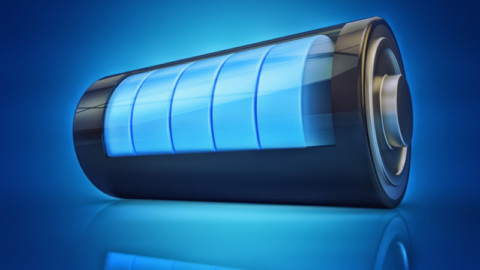by Imogen Hartmann, Editor, Energy magazine
Ask any energy expert what the key ingredient to maximising the efficiency and reliability of renewable energy is and they’ll tell you: the ability to store it cheaply. Australia is ripe with options for generating renewable energy and projects are underway across the country to advance transmission, but ultimately, cost-effective storage solutions will be integral to transitioning our energy system and meeting net zero targets. Researchers from Monash University have created a new class of lithium-sulfur batteries that far outpace and outlast their lithium-ion counterparts.
A team from Monash University’s Faculty of Engineering, led by Professor Matthew Hill, Dr Mahdokht Shaibani and Professor Mainak Majumber, are behind the breakthrough in lithium battery development which centres around a new lithium-sulfur battery interlayer that promotes exceptionally fast lithium transfer, as well as improving the performance and lifetime of the batteries.
The lithium-sulfur battery development, which was funded by the Australian Research Council and Monash University, is cheaper, greener, and enables the charge and discharge of batteries and discharge of energy at a much faster rate than previously offered, with the capacity to be manufactured in Australia.
Lithium-sulfur batteries: a hot commodity
As the world increasingly swaps fossil fuel power for emissions-free electrification, lithium batteries are becoming a vital storage tool to facilitate the energy transition. They are the go-to choice to power everything from household devices like mobile phones, laptops and electric vehicles to major industries such as aviation and marine technology.
Lithium-sulfur batteries offer higher energy density and reduced costs compared to the previous generation of lithium-ion batteries, and they can store two-to-five times as much energy by weight as the current generation of lithium-ion batteries. This means a car with one of these batteries might only need to be charged once a week.
However, previously, the electrodes in lithium-sulfur batteries deteriorated rapidly and the batteries broke down. The new interlayer delivers high capacity and long life. Additionally, lithium-sulfur batteries do not rely on metals like cobalt, nickel and manganese, which are critical minerals found in lithium-ion batteries. These metals are dwindling in supply globally and are often mined in places with high sovereign risk. Sulfur is in abundant supply in Australia and is considered a waste or by-product.
“These batteries are not dependent on minerals that are going to lack supply as the electrification revolution proceeds, so this is another step towards cheaper, cleaner and higher-performing batteries that could be made within Australia,” Professor Hill said.
Developing the technology
“A lithium battery interlayer sits in the middle of the battery and keeps the electrodes apart. It helps lithium get from one side of the battery to the other faster. The new interlayer overcomes the slower charge and discharge rates of previous generation lithium-sulfur batteries,” Professor Hill said.
Professor Hill explained that the interlayer is comprised of special materials that reject polysulfides, chemicals within the battery that can shorten the lifetime if they are allowed to move around freely, and at the same time speeds up how fast lithium can move from one side of the battery to the other, which assists in how fast you can charge or discharge it.
“All this is possible because we made a material that we call SPAF-1, which has tiny holes inside that are the perfect size to allow lithium through and encourage them to move fast. The holes also have a chemical charge on them that stops the polysulfides from entering,” Professor Hill said.
“The development process can track back as far as 2011 when I first discovered these kinds of materials for a completely separate use – cleaning up natural gas sources.
“Our team has been working directly on using the interlayer in lithium-sulfur batteries for around five years now, and we have been working on these batteries more generally for a total of eight years.”
Challenges and opportunities
“The hardest thing with a discovery like this is optimising what ends up being a witch’s brew of components,” Professor Hill said.
Professor Hill said that several active ingredients are mixed to improve the battery performance, but, in order to optimise efficiency, an understanding of the mechanism’s operation is needed to reach peak performance.
“This requires lots of complicated experiments and detailed analysis to bring together,” Professor Hill said.
Despite these challenges, however, Professor Hill said the increased lifetime of the battery (e.g. how many cycles it can be used for), as well as the speed of charging and discharging of the battery, can provide major benefits.
The increased longevity can be attributed to the uniquely designed interlayer, which controls the polysulfides that occur within the battery.
“Lithium-sulfur batteries have the formation of a family of chemicals known as polysulfides, which occur as they are used,” Professor Hill said.
“If left alone, these polysulfides move across the battery and react with the lithium metal anode in undesirable ways. This can cause the formation of little wires of lithium which we call dendrites, and pretty soon a short circuit can happen, and the battery can no longer be charged or discharged.
“The interlayer controls where the polysulfides can travel inside the battery, keeping them on the cathode side. “What’s exciting is that we managed to do this at the same time as also helping the lithium to travel faster.”
Commercialisation and cost: the early stages
According to Professor Hill, the next key step will be to create a larger version of the battery, which is expected to improve investor confidence in the lithium-sulfur battery’s commercial-scale viability. Professor Hill said that, although it’s still very much in the early stages in terms of putting a price on the interlayer, the narrowness of the material is a great start.
“The key thing is that it is very very thin – so we don’t need much material to make it work,” Professor Hill said.
Professor Hill said the lithium sulfur battery interlayer has the potential for mass manufacture, and holds similar attributes to other porous materials that have been translated to industry for commercial use.
Time will tell how we see the technology utilised in the broader industry, but for Professor Hill and his colleagues, the future of the lithium-sulfur battery is bright.

















